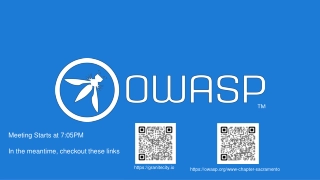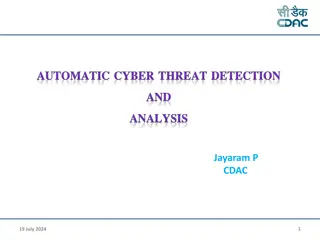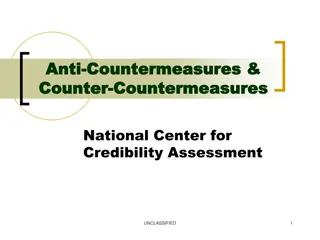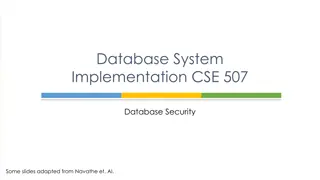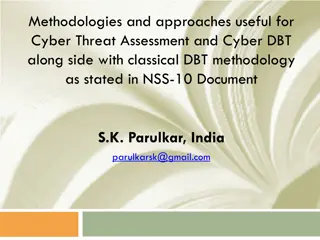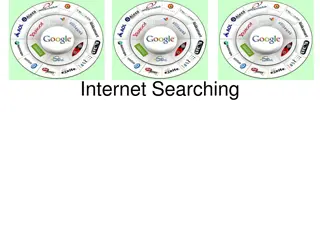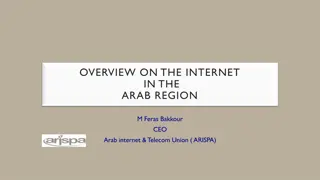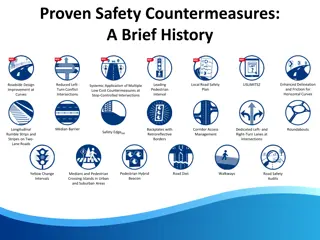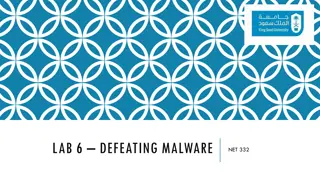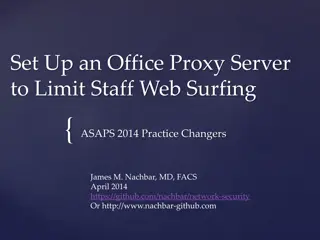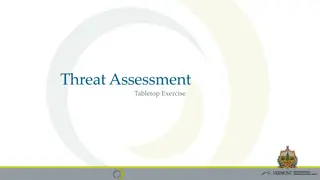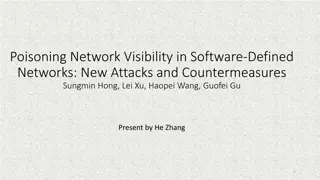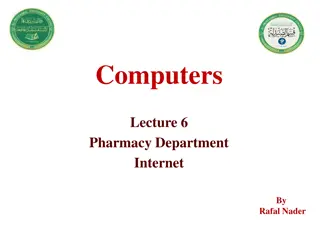Understanding Internet Threat Landscape and Countermeasures
Delve into the complexities of identifying and mitigating threats in cyberspace at scale. Explore the challenges of detecting malicious activities, the need for broad-based blocklists, and the importance of tracking provider abuse percentages. Learn about the Pwnage Cycle, ICANN's efforts in measuring abuse, and the impact of evolving cyber threats on network security. Discover innovative strategies to combat cyber threats effectively.
Uploaded on Sep 12, 2024 | 0 Views
Download Presentation

Please find below an Image/Link to download the presentation.
The content on the website is provided AS IS for your information and personal use only. It may not be sold, licensed, or shared on other websites without obtaining consent from the author. Download presentation by click this link. If you encounter any issues during the download, it is possible that the publisher has removed the file from their server.
E N D
Presentation Transcript
Identifying Internet Bad Neighborhoods at Scale John Bambenek ThreatSTOP
Sharing Restrictions This talk is TLP:WHITE, no confidential or private information is contained. Share away.
About me VP of Security Research and Intelligence at ThreatSTOP PhD student in Informatics focusing on cybersecurity machine learning.
The Pwnage Cycle Attack Breach Potential long gap between breach and detection Detection Analysis Distribution Maybe, but threat sharing is another problem Protection
Pwnage Cycle TL;DR We not only have to wait for attackers to strike to develop defenses, we have to wait for our detection. On a time scale, we re setup to always lose.
Scale of attacks There are too many samples of malware (much less attacks generally) that could ever be analyzed. Firewalls can t hold all the malicious IP addresses we have. IPv6 (when fully adopted) will break many of the systems we use due to scale. Imagine IP rep just on an /64 in IPv6. What will Shodan do?
Creating Broad-based Blocklists Criminals, in some cases, congregate around specific providers. Calculate abuse % of those providers: TLD ASN Authoritative Nameserver Registrar* Block at the broadest possible level, be precise when necessary.
ICANN DAAR ICANN set up a means to measure abuse by TLD and Registrar. Registries and Registrars hate it and no substantial results are released. Took # of abuse domains in list of feeds and divided by total number of domains in TLD or by Registrar.
Why Track Provider Abuse% Promotes, encourages or engages in any spam or other unsolicited bulk email, or computer or network hacking or cracking; GoDaddy ToS Anti-spam companies data is built into everything , clear economic consequences, so the usual we don t police content doesn t fly. If we could put the same pressure for cybercrime generally, some providers may be more helpful.
Abuse by TLD Take raw list of hostnames, reduce to domains and dedup. Count and calculate total abuse % based on total number of domains. Note- some TLDs have started wildcard-ing non-registered domains. Some ccTLDs operate as free domains (i.e. .tk).
TLD Findings Very different from what Anti-Spam companies publish Data, in this case, is from abuse and malware feeds, not just spam. Surbl and SpamHaus have very different results. Spam feeds include scammy or loud domains for e-mail. Important to note data sources and selection bias matter greatly. Very quick dropoff in abuse rates.
Ranking ASNs by Abuse Predecessor: https://bgpranking.circl.lu does modify IoCs by threat type. (Now running again!) Basic approach is to total all IPs in an AS and the abusive IPs in an AS can do math.
ASN Findings There were quite a few 100% abusive ASNs (not shown in graph) due to blocking entire netblocks Graph shows anything less than 100% abusive. Even bulletproof hosters have legit customers. Use this to mathematically determine abuse-friendly providers. Then can use to block. Lots of highly abusive ASNs.
An interesting side benefit Analyzing the data this way led to lots of rabbit holes It also provided insight into quality issues of third-party feed providers and how they are creating and (not) curating data.
MyEtherWallet MyEtherWallet.com is an ethernet web-wallet provider. Scammers created tons of MyEtherWallet.* domains. EtherScamDB basically dumped a list of all TLDs and put everything not .com in their list. One such domain is MyEtherWallet.va which was never registered. And it s not trivial to get a Vatican City domain name.
SpamHaus (and anti-spam lists in general) They block (rightly) entire netblocks. Some of those blocks are quite expansive. 128.85.0.0/16 ARIN 1.19.0.0/16 APNIC 101.134.0.0/15 APNIC 101.42.0.0/16 cnisp.org.cn SBL210373 SBL434604 SBL434605 SBL434606 15-Jan 2014 25-Feb 2019 25-Feb 2019 25-Feb 2019 When calculating ASN abuse %, AS0 was worst offender. Some of those netblocks are unallocated subblocks or allocated to other ASes (also cymru and iptoasn aren t completely identical in their mappings). But spam DOES originate from unallocated space from time to time
Name-Server This is more complicated, no one distributes nameserver information or blocklists. Creating master list of all domains with auth nameservers is non- trivial (you can do it with WhoisXMLApi data). Need to start with a whitelist first.
Creating Nameserver Reputation Using WhoisXMLApi database, it s possible to count auth nameservers by domains served. CZDS is a possibility, but doesn t include most ccTLDs. In domains, popular is used as a whitelist (i.e. alexa, umbrella, majestic). Same concept here. Data published eventually here: https://github.com/threatstop/authns-whitelist
Auth Nameserver Whitelist 10429085,ns02.freenom.com 10429085,ns01.freenom.com 10429068,ns04.freenom.com 10429068,ns03.freenom.com 3889206,f1g1ns1.dnspod.net 3888099,f1g1ns2.dnspod.net 3876521,dns1.registrar-servers.com 3872669,dns2.registrar-servers.com 3143858,nsg2.namebrightdns.com 3143841,nsg1.namebrightdns.com 2548276,www.eurid.eu 2313783,ns2.123-reg.co.uk 2313105,ns.123-reg.co.uk 2204168,dns10.hichina.com
Auth Nameserver IP Whitelist 769325,162.88.61.49 769146,162.88.60.49 771461,162.88.60.47 771404,162.88.61.47 713596,162.251.82.250 698036,162.251.82.249 698036,162.251.82.248 700472,162.251.82.246 713596,162.251.82.123 713596,162.251.82.122 698036,162.251.82.121 700472,162.251.82.119
Findings The Internet is much more centralized than we give it credit for. Blocking the wrong nameserver or IP could disable millions of sites quickly.
Registrar Some registrars are more amenable to criminality than others. Whois database will also have registrar information. Turning this into a blocklist would reintroduce the scale problem (you still have to list all domains individually). Some may have managed DNS though. Not done at this phase.
Results Reports will be published and updated at Threatstop.com once they are production-ready . Other efforts are underway to create open provider reputational data. More info soon .
Interesting Data Point I Cant Example Yet Number Malicious Domains by Minimum Resolution Age in Days 120000 100000 80000 60000 40000 20000 0 0 10 20 30 40 50 60 70
Next Steps Adding TLD, ASN, Registrar, Nameserver reputational data to machine learning classifier on domains. Prototype ML classifier uses 10 domain DNS attributes to reliably classify a domain malicious (~95% accuracy). The single biggest (by far) criteria to determine a domain is malicious, the absence of an MX record.
Online Resources The online jupyter notebook binder is available at: https://mybinder.org/v2/gh/bambenek/abuserates/master Need to finish auto-updating the data, should be done soon. Github repo : https://github.com/bambenek/abuserates
Questions? John Bambenek / @bambenek jbambenek@threatstop.com


